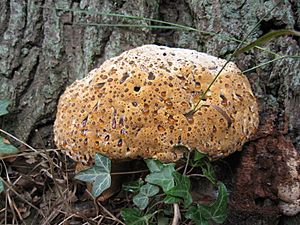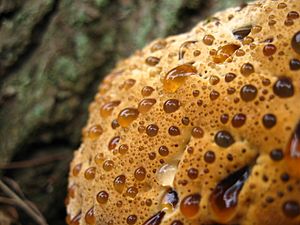Inonotus dryadeus facts for kids
Quick facts for kids Inonotus dryadeus |
|
|---|---|
 |
|
| Inonotus dryadeus on an oak tree | |
| Scientific classification | |
| Genus: |
Inonotus
|
| Species: |
dryadeus
|
| Synonyms | |
The Inonotus dryadeus, often called the oak bracket or weeping polypore, is a type of fungus. It's known for growing on oak trees, usually near the bottom of the trunk. This fungus is inedible, meaning you can't eat it. It's called the "weeping polypore" because it can ooze a sticky, amber-colored liquid from its top surface.
Contents
What is the Weeping Polypore?
The Inonotus dryadeus is a kind of bracket fungus. These fungi grow outwards from trees like shelves or brackets. Its main body, called the fruiting body, can be quite large. It usually measures from 5 to 30 centimeters (about 2 to 12 inches) wide. Some have even been found as big as 75 centimeters (about 30 inches)!
The top of this fungus feels like velvet. It's usually cream to rusty brown, with a lighter yellow edge. This surface has many small holes, or tubes, up to 3 centimeters (about 1 inch) deep. When the fungus is young, these tubes often drip an orange-brown liquid. This is why it's nicknamed the "weeping conk."
If you look underneath, you'll see tiny pores. There are about 4 to 6 of these fine pores in every millimeter. They start out greyish-white and then turn yellow or ochre as they get older. The inside of the fungus is soft and stringy, with a yellow-brown color. It also has a smell that most people find unpleasant.
Tiny Spores
Like all fungi, the weeping polypore reproduces using spores. These spores are very tiny, white, and smooth. They are round and measure about 6.5 to 8 micrometers across. You would need a microscope to see them!
Similar Fungi
There are other fungi that look a bit like the weeping polypore. For example, Inonotus cuticularis is a similar type of fungus. However, I. cuticularis usually grows on different trees, such as beech, sycamore, and elm, instead of oak.
Where Does the Weeping Polypore Live?
The Inonotus dryadeus is a parasitic fungus. This means it lives on and gets its food from another living thing, in this case, a tree. It's also a saprobic fungus, which means it can also get nutrients from dead or decaying matter.
The spores of this fungus enter trees through wounds. These wounds can be from storms, animals, or even human activity. While it can grow on maple, elm, and chestnut trees, it mostly affects oak trees.
This fungus primarily causes decay in the tree's roots, especially the parts underground. It can be hard to know if a tree has this fungus if you don't see the fruiting bodies. The fruiting bodies usually grow close to the ground on the tree trunk. They can appear alone or in groups and are strongly attached to the tree.
You can find Inonotus dryadeus in North America and cooler parts of northern Europe. It's considered widespread but might only be common in certain areas. The fruiting bodies usually appear in summer and autumn. They can even stay on the tree through winter and last for several years. Over time, they turn black and develop cracks. If you see a fruiting body, it's a sign that the fungus's main body, called the mycelium, has grown into the tree's root crown. This can weaken the tree's roots.
See also
 In Spanish: Pseudoinonotus dryadeus para niños
In Spanish: Pseudoinonotus dryadeus para niños


